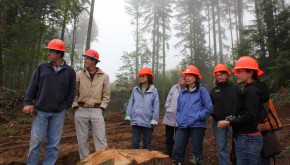
Across the United States, more women are becoming primary managers/owners of farms and forests, yet these women often lack the social capital, knowledge, and access to resources that allow them to be successful. An Oregon Family Forest Landowner Survey conducted in 2005 estimated that women were primary managers of 40% of Oregon’s family forests, but only comprised 20-25% of education participants and 10% of professional association membership (Cloughesy 2005). A study of forestlandowner offspring conducted for the National Association of State Foresters showed that 83% of women sampled were interested in managing their family forestland when transfer occurred, but only 34% felt they had enough knowledge to make forest management decisions (Mater 2005). According to the USDA 2007 Agriculture Census, women who own or manage forests and farms tend to have smaller parcels, lower average sales, and are less likely to attend educational events or be aware of assistance opportunities (Dougherty and Hilt 2009). These factors lead to an increased risk of economic failure for these women, many times resulting in sale and conversion of working forests and farms to other uses, including residential or commercial development.
In 2005 Oregon State University (OSU) Forestry and Natural Resources Extension worked with a female steering committee to develop Women Owning Woodlands Network (WOWnet), an Extension program designed to: a) recognize the growing number of women taking a wide array of active woodland management roles, b) raise basic forestry and decision-making skill levels among women woodland managers through hands-on educational opportunities, c) support and increase women’s access to forestry-related resources, and d) encourage communication among Oregon’s women woodland managers through the development of statewide and local networks. In four years, this program has grown to include 300 members in nine counties, holding between 24 – 36 programs per year. At a national level, many other states, including Minnesota and Pennsylvania are currently looking to the Oregon WOWnet as a model to develop their own programs.
Why Women?
Despite evidence of an overall shift towards a more gender-inclusive forestry, gender roles can still be limiting for many women. WOWnet participants express that traditional and inflexible perceptions of gender roles in forestry are problematic and present a major challenge to them entering the forestry community.
Women can face barriers in accessing forestry knowledge that hinder their achievement of management goals. Engaging them in organizations like WOWnet, the Society of American Foresters, and Oregon Small Woodlands Association is a key step to improving women’s overall awareness of forest management, forest standards, and forest regulations.
Why Peer-Learning?
There are many comprehensive educational programs in Oregon that target family forestland stewardship. The problem has not been a lack of availability of educational opportunities for these women, but a perceived lack of acceptance and relevance of materials to those who did not consider themselves traditional forest, or timber managers. The original goal of WOWnet was, and remains today, to increase social capital and confidence among women woodland managers so they feel theyhave a place within the greater forestry community. One of the ways WOWnet accomplishes these goals is by allowing local WOWnet groups to become self-directed immediately. At the first session of any local group, WOWnet members prioritize topics and choose the location and dates of subsequent sessions. At the end of every workshop, women discuss the next session, topic and location. Typically, WOWnet participants take turns hosting tours and workshops on their own properties with OSU Extension serving as technical resource and facilitator.
A collaborative or peer learning environment not only increases basic vocabulary, knowledge and technical skills through hands-on workshops, but allows participants to see their own experiences as knowledge, by sharing those experiences their peers. This format has also proven very successful at bringing a more diverse population of landowners, with divergent management strategies, together in a respectful setting. Women, and men for that matter, have attended WOWnet sessions when they didn’t think they would fit in at a more “conventional” forestry program. One of the benefits of WOWnet has been to dispel these myths and help WOWnet participants see how they can benefit from participating in additional groups such as the Oregon Small Woodlands Association, and educational opportunities like local OSU Extension programs. After three years, WOWnet members are increasingly engaging with, and providing leadership roles for other within the greater forestry community. WOWnet is empowering women to grow from silent observers, to active learners and inquirers, to mentors and teachers themselves. As stated by one member:
“I have just been so jazzed now because there are other women who are joining who are newer and they’re calling me. It’s like I’ve done something!”
Peer Learning 2.0
There is an opportunity to apply peer-learning networks like Oregon’s WOWnet and comparable programs in Alabama (Women in Land Ownership, WiLO) and Maine (Women and the Woods Program) not only to women forest owners and farmers, but other targeted groups as well. WOWnet has demonstrated this model as an effective educational tool that expands knowledge, provides a venue for social networking, and raises a sense of personal authority among participants. Through peer-learning, we recognize many sources of knowledge and forest management diversity, which empowers individuals and ultimately strengthens the family forestland owner community.

